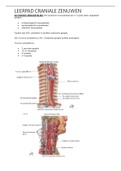Overig
Hoorcolleges psychofarmacologie
Hierin staan uitgebreide uitwerkingen van de lectures van het vak Psychopharmacology . Er is geen samenvatting van gemaakt maar uitgebreid beschreven wat er in de hoorcolleges gezegd is. Geschreven in het Engels (naar de taal waarin hoorcolleges zijn gegeven.
[Meer zien]














